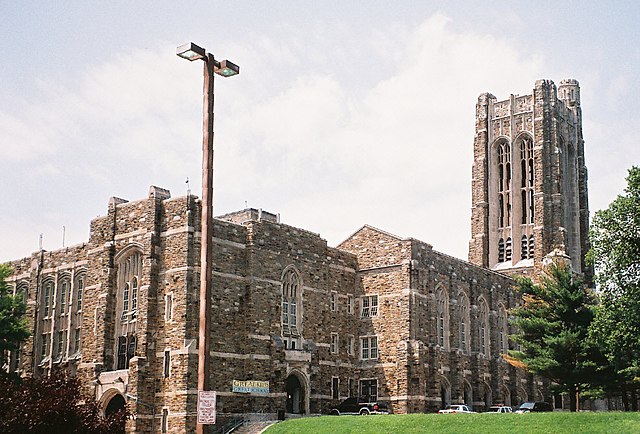Baltimore City College: Difference between revisions - Wikipedia
 Article Images
Article Images
Tags: Mobile edit Mobile web edit
m
Line 228:
By the early [[1890s]], the City College was playing in the newly organized [[Maryland Intercollegiate Football Association]] (M.I.F.A.), a nine-member athletic league consisting of colleges and schools in [[Washington, D.C.]], and Maryland area.<ref>Kings of American Football: The University of Maryland, 1890–1952, p. 28, Columbia Publishing Co., 1952ns".</ref> City College was the lone secondary school among the old MIFA membership. The B.C.C. 1895 football schedule included [[St. John's College (Annapolis/Santa Fe)|St. John's College]] of [[Annapolis, Maryland|Annapolis]], [[Swarthmore College]], the [[United States Naval Academy]] at [[Annapolis, Maryland|Annapolis]], the former Maryland Agriculture College, (which later became after a [[1920]] merger (with the older original [[University of Maryland, Baltimore|University of Maryland at Baltimore]] campus since 1807) to become the [[University of Maryland at College Park]], and also the [[Washington College]] across the [[Chesapeake Bay]] in [[Chestertown, Maryland]] (on the [[Eastern Shore of Maryland]]).<ref name="leonhart200">Leonhart (1939), p. 200.</ref> Between 1894 and 1920, the City College "Collegians" regularly faced off also against their neighbors at Howard and Centre Streets of the [[Johns Hopkins Blue Jays men's lacrosse|Johns Hopkins University "Blue Jays"]] and the [[Navy Midshipmen men's lacrosse|Navy Midshipmen]] in our state's team sport of [[Lacrosse|lacrosse]].<ref>{{cite web|url=http://grfx.cstv.com/photos/schools/jhop/sports/m-basebl/auto_pdf/2012-13/misc_non_event/series-history.pdf|title=Series Records vs. All Opponents|publisher=Johns Hopkins Baseball Record Book|pages=29–44|access-date=March 8, 2014|archive-date=March 8, 2014|archive-url=https://web.archive.org/web/20140308233554/http://grfx.cstv.com/photos/schools/jhop/sports/m-basebl/auto_pdf/2012-13/misc_non_event/series-history.pdf|url-status=dead}}</ref><ref>{{cite web|url=http://grfx.cstv.com/photos/schools/navy/sports/m-lacros/auto_pdf/2012-13/misc_non_event/opponents.pdf|title=ll-Time Series Records|publisher=navysports.com|page=31|access-date=March 8, 2014|archive-date=March 8, 2014|archive-url=https://web.archive.org/web/20140308220522/http://grfx.cstv.com/photos/schools/navy/sports/m-lacros/auto_pdf/2012-13/misc_non_event/opponents.pdf|url-status=dead}}</ref>
The Baltimore City College began competing on a regular extensive program schedule against the then few other public high schools and the many more numerous private / independent or parochial secondary schools in 1919 when it was invited to join the [[Maryland Interscholastic Athletic Association|Maryland Scholastic Association (M.S.A.)]] as a founding member institution, with its organizing co-founder and B.C.C. teacher / coach (and future 10th Principal) Dr. Philip H. Edwards leading to form the new public / private athletic league.<ref>{{cite web|url=http://articles.baltimoresun.com/1992-11-17/news/1992322108_1_schmied-memorial-stadium-city-public-schools|title=Otto K. Schmied, 101, city school supervisor|date=November 17, 1992|work=The Baltimore Sun}}</ref> Unfortunately, after 74 years of governing Baltimore metro area boys' high school athletics, the old Maryland Scholastic Association dissolved in 1993 when its 15 public high school members from the [[Baltimore City Public Schools]] including City College and its traditional arch-rival of the Polytechnic Institute, withdrew from the notable and unique public / private schools athletic league (rare throughout the nation) after 74 years under instructions from a new Baltimore City Public Schools superintendent (who had transferred from a position and career formerly in the surrounding suburban [[Baltimore County]] public schools system) and require the City's high schools to join the larger and widespread state association of public secondary schools (excluding competition with its former opponents in the private / independent and Roman Catholic high schools who had long been respected rivals / competitors for three-quarters of a century). So now Baltimore City schools joining the [[Maryland Public Secondary Schools Athletic Association]] its own racial integration controversy in the mid 1950s as several predominantly white high schools in the surrounding rural and suburban counties in the state did not wish to compete or play against the three black secondary schools in Baltimore City or the one high school recently opened near the [[County seat|county seat]] of [[Towson, Maryland|Towson]] in [[Baltimore County]] or others in Washington, D.C. or the very few others scattered around the state. The M.P.S.S.A.A., organized later after the old M.S.A. of 1919, was formed in the post-[[World War II]] period in 1946. Unfortunately this newer state athletic conference failed in its responses and policies until much later during the nationwide Civil Rights Movement up into the [[1960s]].ref>{{cite web|url=http://www.capitalgazette.com/news/the-dissolution-of-the-maryland-scholastic-association-will/article_8a5db259-4572-5537-8ae2-372619a8a47b.html?mode=jqm |archive-url=https://archive.today/20140308231846/http://www.capitalgazette.com/news/the-dissolution-of-the-maryland-scholastic-association-will/article_8a5db259-4572-5537-8ae2-372619a8a47b.html?mode=jqm |url-status=dead |archive-date=March 8, 2014 |title=The dissolution of the Maryland Scholastic Association |author=Wagner, Bill |date=September 19, 1993 |publisher=Capital Gazette }}</ref>
[[Baltimore City Public Schools] including City College and its traditional arch-rival of the Polytechnic Institute, withdrew from the notable and unique public / private schools athletic league (rare throughout the nation) after 74 years under instructions from a new Baltimore City Public Schools superintendent (who had transferred from a position and career formerly in the surrounding suburban [[Baltimore County]] public schools system) and require the City's high schools to join the larger and widespread state association of public secondary schools (excluding competition with its former opponents in the private / independent and Roman Catholic high schools who had long been respected rivals / competitors for three-quarters of a century). So now Baltimore City schools joining the [[Maryland Public Secondary Schools Athletic Association]] its own racial integration controversy in the mid 1950s as several predominantly white high schools in the surrounding rural and suburban counties in the state did not wish to compete or play against the three black secondary schools in Baltimore City or the one high school recently opened near the [[County seat|county seat]] of [[Towson, Maryland|Towson]] in [[Baltimore County]] or others in Washington, D.C. or the very few others scattered around the state. The M.P.S.S.A.A., organized later after the old M.S.A. of 1919, was formed in the post-[[World War II]] period in 1946. Unfortunately this newer state athletic conference failed in its responses and policies until much later during the nationwide Civil Rights Movement up into the [[1960s]].ref>{{cite web|url=http://www.capitalgazette.com/news/the-dissolution-of-the-maryland-scholastic-association-will/article_8a5db259-4572-5537-8ae2-372619a8a47b.html?mode=jqm |archive-url=https://archive.today/20140308231846/http://www.capitalgazette.com/news/the-dissolution-of-the-maryland-scholastic-association-will/article_8a5db259-4572-5537-8ae2-372619a8a47b.html?mode=jqm |url-status=dead |archive-date=March 8, 2014 |title=The dissolution of the Maryland Scholastic Association |author=Wagner, Bill |date=September 19, 1993 |publisher=Capital Gazette }}</ref>
The "Black Knights" currently compete with other public secondary schools in the MPSSAA (Class 3A, North Region, District 9), more commonly referred to as the Baltimore City League (Division 1), Efforts are made to routinely or occasionally schedule contests against other old former adversaries of past decades with area private, independent and parochial high schools in various sports such as longtime opponents [[Loyola Blakefield|Loyola High School at Blakefield]] and its traditional arch-rival [[Calvert Hall College High School|Calvert Hall College (high school)]], which City had been playing against for over 125 years.{{Citation needed|date=January 2021}}